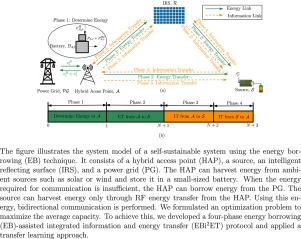自我持续的irs辅助双向通信EBi2ET协议:一种迁移学习方法
IF 2.2
4区 计算机科学
Q3 ENGINEERING, ELECTRICAL & ELECTRONIC
引用次数: 0
摘要
物联网(IoT)网络需要传感器为各种应用收集实时数据,但它们的电池容量有限,无法提供无处不在的服务。在这项工作中,我们通过引入能量借用(EB)机制来确保可靠的双向通信,解决了智能反射面(IRS)辅助无线通信网络(wpcn)中的关键能量限制。我们开发了一个新的框架,eb辅助的集成信息和能量传输(EBi2ET)协议,用于自我可持续的物联网网络。在这里,混合接入点(HAP)通过IRS与源(或传感器)节点进行双向通信。为了自给自足,HAP从周围的太阳能/风能中获取能量。但对于无处不在的能源供应,HAP从电网(PG)借用能量,并在从环境能量收集(EH)中获得足够能量时,有利息地返回能量。此外,HAP利用非线性射频EH (RF-EH)通过IRS将能量传递给源。然后,HAP和source都进行双向通信。为了增强自持续通信,我们制定了一个联合优化问题,旨在最大化双向数据速率,同时考虑能源交易。尽管在未知环境中管理这些事务和双向通信存在挑战,但我们通过将问题转换为马尔可夫决策过程(MDP)有效地解决了这些问题。利用深度确定性策略梯度(Deep Deterministic Policy Gradient, DDPG)算法,我们推导出连续动作空间内的最优在线策略。为了进一步加速收敛和提高稳定性,我们采用了一种基于迁移学习(TL)的DDPG方法。最后,我们通过与现有基准方案的性能比较证明了我们提出的方法的优越性,其中EBi2ET协议实现了令人印象深刻的193.58%的平均性能增益。此外,没有TL、IRS-WPCN、EBi2ER和i2ER协议的TD3也比基准分别提高了187.33%、95.33%、67.02%和43.18%。本文章由计算机程序翻译,如有差异,请以英文原文为准。

EBi2ET protocol for self-sustainable IRS-assisted bidirectional communication: A transfer learning approach
Internet of Things (IoT) networks require sensors to collect real-time data for various applications, but they have limited battery capacity for ubiquitous services. In this work, we address the critical energy limitations in intelligent reflecting surface (IRS)-assisted wireless powered communication networks (WPCNs) by introducing an energy borrowing (EB) mechanism to ensure reliable bidirectional communication. We develop a novel framework, EB-assisted integrated information and energy transfer (EBiET) protocol for self-sustainable IoT networks. Here, a hybrid access point (HAP) performs bidirectional communication with a source (or sensor) node via an IRS. For self-sustainability, HAP harvests energy from the ambient solar/wind. But for ubiquitous energy supply, HAP borrows energy from the power grid (PG) and returns the energy with interest, when it has sufficient energy from the ambient energy harvesting (EH). Further, HAP transfers the energy to the source via IRS using nonlinear radio frequency EH (RF-EH). Then, both HAP and source perform bidirectional communication. To enhance self-sustainable communication, we formulate a joint optimization problem aimed at maximizing the bidirectional data rate while accounting for energy transactions. Although managing these transactions and bidirectional communications in an unknown environment presents challenges, we address them effectively by transforming the problem into a Markov Decision Process (MDP). Leveraging the Deep Deterministic Policy Gradient (DDPG) algorithm, we derive the optimal online policy within a continuous action space. To further accelerate convergence and improve stability, we incorporate a transfer learning (TL)-based DDPG approach. Lastly, we demonstrate the superiority of our proposed method through performance comparisons with existing benchmark schemes, where the EBiET protocol achieves an impressive average performance gain of 193.58%. Furthermore, TD3 without TL, IRS-WPCN, EBiER, and iER protocols also yield notable improvements of 187.33%, 95.33%, 67.02%, and 43.18%, respectively, over the benchmark.
求助全文
通过发布文献求助,成功后即可免费获取论文全文。
去求助
来源期刊

Physical Communication
ENGINEERING, ELECTRICAL & ELECTRONICTELECO-TELECOMMUNICATIONS
CiteScore
5.00
自引率
9.10%
发文量
212
审稿时长
55 days
期刊介绍:
PHYCOM: Physical Communication is an international and archival journal providing complete coverage of all topics of interest to those involved in all aspects of physical layer communications. Theoretical research contributions presenting new techniques, concepts or analyses, applied contributions reporting on experiences and experiments, and tutorials are published.
Topics of interest include but are not limited to:
Physical layer issues of Wireless Local Area Networks, WiMAX, Wireless Mesh Networks, Sensor and Ad Hoc Networks, PCS Systems; Radio access protocols and algorithms for the physical layer; Spread Spectrum Communications; Channel Modeling; Detection and Estimation; Modulation and Coding; Multiplexing and Carrier Techniques; Broadband Wireless Communications; Wireless Personal Communications; Multi-user Detection; Signal Separation and Interference rejection: Multimedia Communications over Wireless; DSP Applications to Wireless Systems; Experimental and Prototype Results; Multiple Access Techniques; Space-time Processing; Synchronization Techniques; Error Control Techniques; Cryptography; Software Radios; Tracking; Resource Allocation and Inference Management; Multi-rate and Multi-carrier Communications; Cross layer Design and Optimization; Propagation and Channel Characterization; OFDM Systems; MIMO Systems; Ultra-Wideband Communications; Cognitive Radio System Architectures; Platforms and Hardware Implementations for the Support of Cognitive, Radio Systems; Cognitive Radio Resource Management and Dynamic Spectrum Sharing.
 求助内容:
求助内容: 应助结果提醒方式:
应助结果提醒方式:


